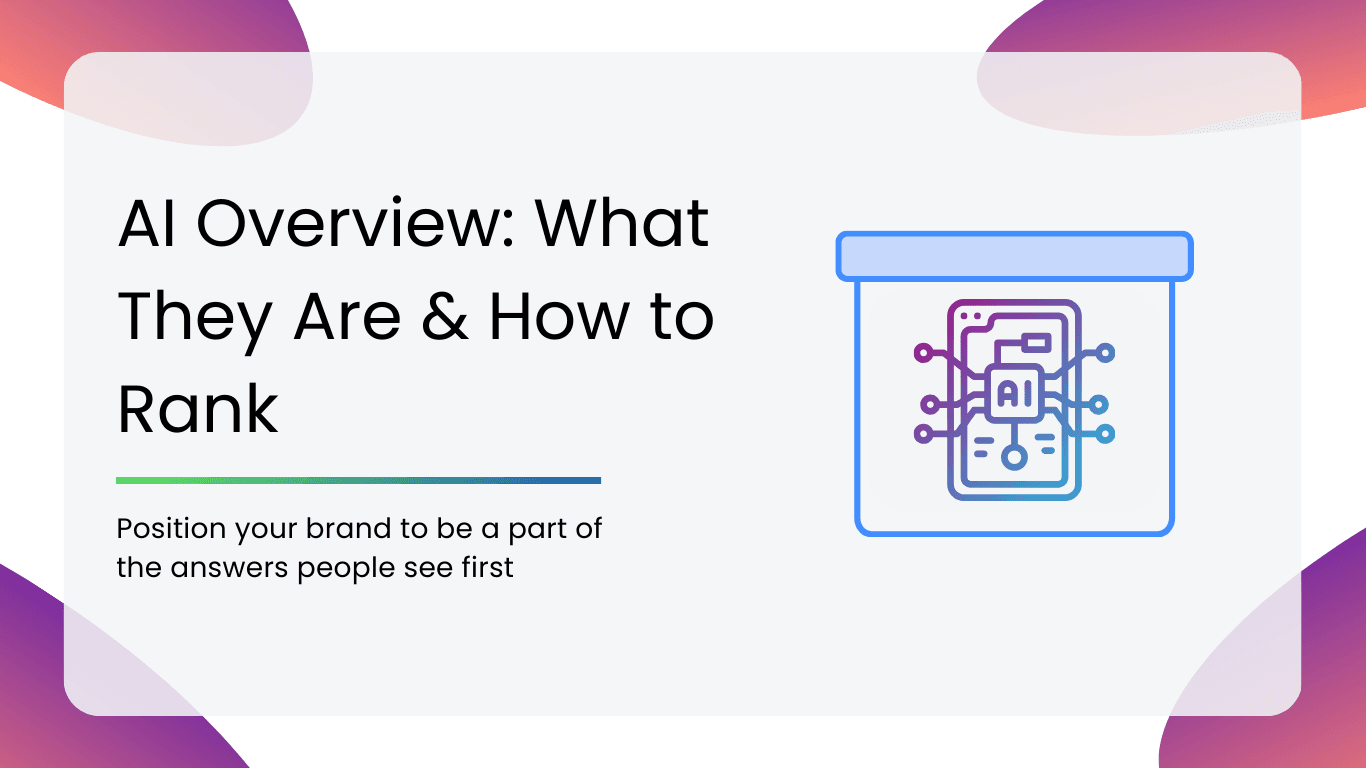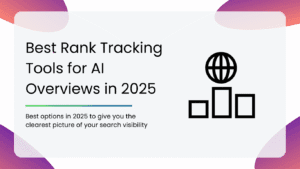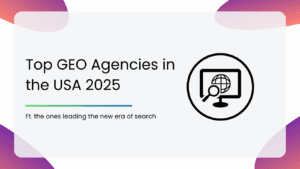AI Overviews are taking over these days! As search gets more conversational and task-focused, those AI-generated summaries at the top of results are quickly becoming of prime importance. They pull info from across the web, stitch it together into quick answers, and can make or break your visibility.
So, should you care? If you want your brand discovered without users ever scrolling, absolutely!
What are AI Overviews?
AI Overviews are essentially AI-generated summaries that pop up right in your search results page. Powered by Google and the Knowledge Graph, they pull data from multiple sources and present it in a neat format, so users get answers without ever leaving Google.
You’ll usually see them sitting right above the organic results and often just below ads. That’s prime screen space, exactly where your customer’s eyes land first.
As of 2025, AI Overviews are live in 100+ countries, including the US, UK, India, Japan, Indonesia, Mexico, and Brazil.
Different Layouts You’ll Spot
AI Overviews don’t look the same every time. Depending on the query, they can show up as:
- Paragraphs: Short, to-the-point explanations (great for quick facts).
- Lists: Step-by-step instructions or recommendations.
- Itineraries & Product Cards: Perfect for travel planning or shopping queries.
When Do They Appear?
AI Overviews show up most often when people are looking for more than just a quick definition:
- Informational Queries: “What are probiotics good for?”
- Planning Queries: “3-day itinerary for Goa”
- E-Commerce Queries: “Best Budget smartphones under Rs. 15,000”
- YMYL (Your Money, Your Life) Queries: “How to reduce cholesterol naturally”
In short, if a search requires context, comparison, or step-by-step help, expect AI Overview to take care of it.
How Do AI Overviews Work
AI Overviews combine the large language models (LLMs) with Google’s traditional ranking signals and the Knowledge Graph. That means your content isn’t just competing for keywords, it’s being evaluated for authority, trust, and relevance on a whole new level.
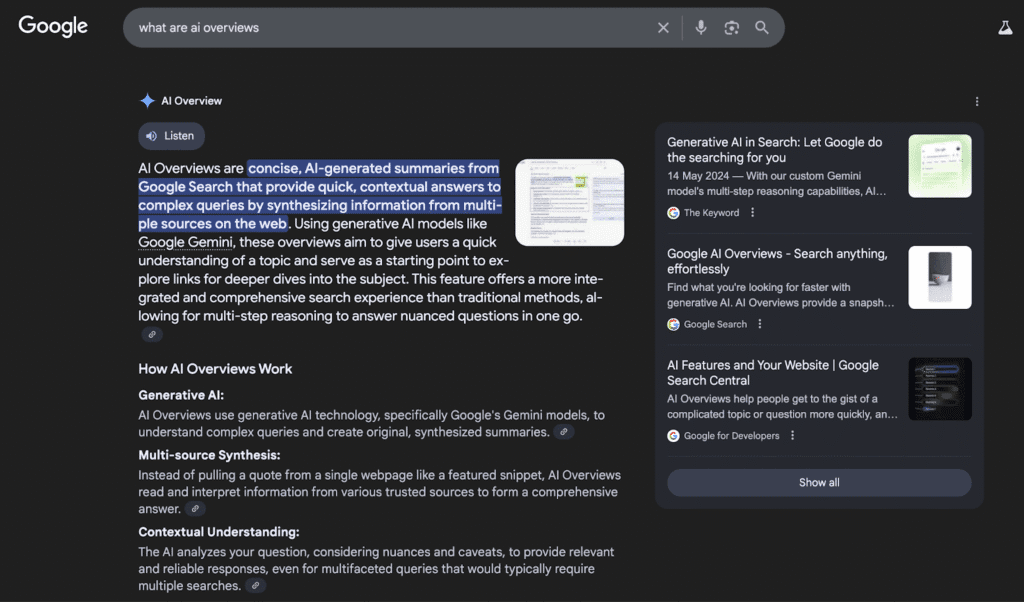
Where They Pull Information From
The AI isn’t making stuff up out of thin air. It pulls directly from:
- High-Authority Sources: Sites with proven credibility
- Topically Relevant Pages: Content that matches the exact intent of the query
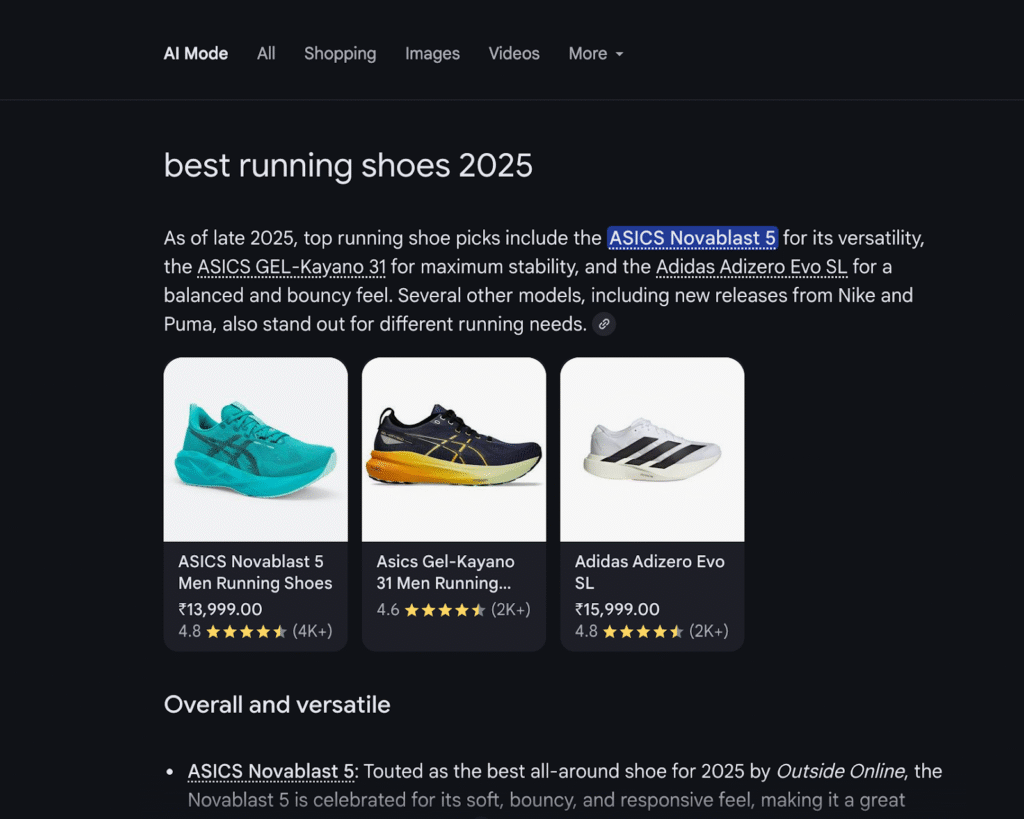
Links That Stand Out
Unlike old-school snippets, the links in AI Overviews appear as “cards.” These aren’t hidden citations at the bottom; they’re clickable, visual elements that invite the user to explore further. Getting your link featured here leads to major visibility.
They Adapt to Intent
AI Overviews aren’t static. They change depending on what the searcher is really after:
- Expand Options: Users can dive deeper with a link
- Replace Features: Swap in alternative angles or products
- Interactive Elements: Like filtering, comparing, or planning
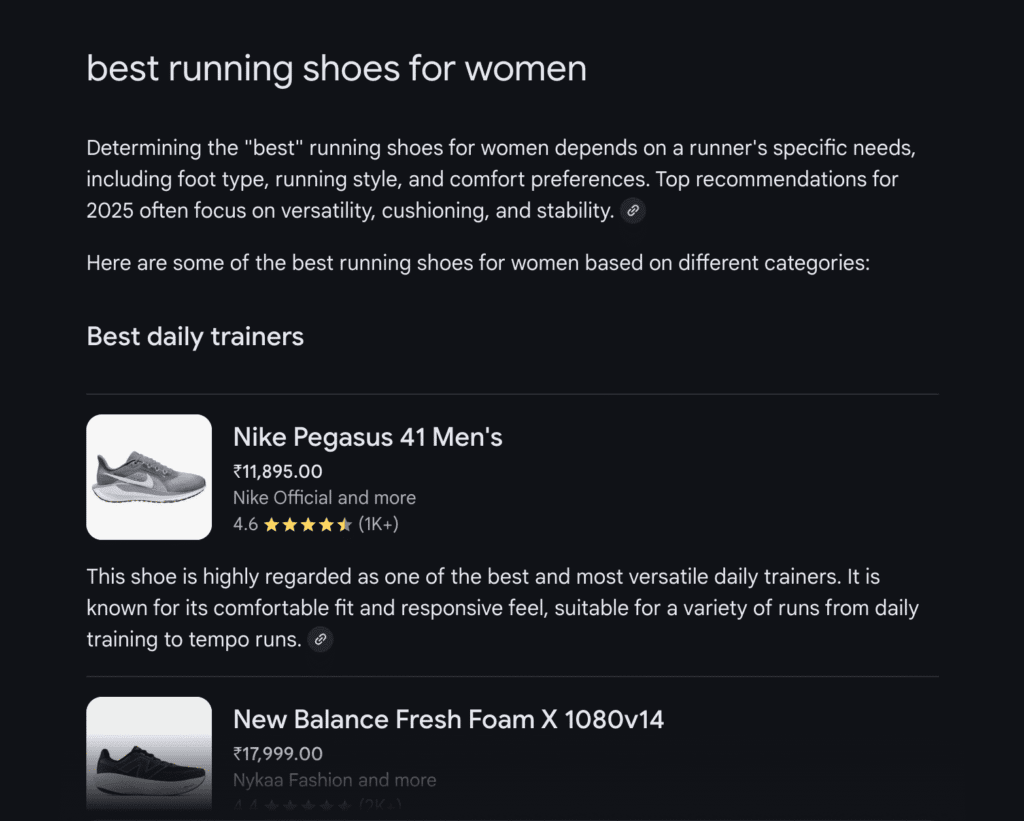
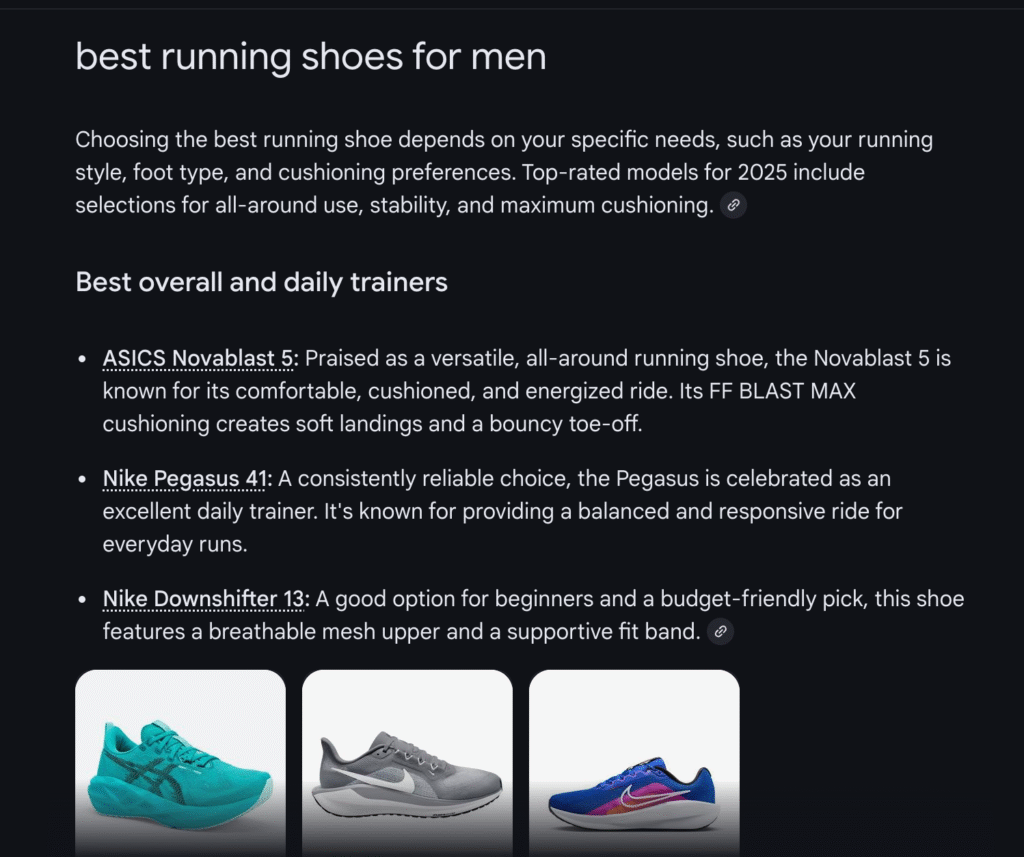
Current State of AI Overviews (2025 Snapshots)
So, where do we stand with AI Overviews right now? In short, they’re powerful but not everywhere (yet).
- Rare Appearances: According to Semrush Sensor in March 2025, they currently show up for only about 13.14% of all queries.
- Focused on Complexity: You’re more likely to see them when searches involve multi-step planning or layered questions, not just a single keyword lookup.
- Volatile Behavior: AI Overviews are unstable. A query might trigger one today, vanish tomorrow, and reappear next week.
Why AI Overviews Matter for SEO
AI Overviews are a game-changer for SEO. Whether you see them as a threat or an opportunity depends on how well your content adapts.
The Challenges
- Fewer Clicks Overall: With summaries answering the query upfront, zero-click searches are on the rise. Some users may never scroll past the overview.
The Opportunities
- More Qualified Clicks: Google claims that when links are included in AI Overviews, they actually get higher click-through rates compared to normal blue links. It’s because you’re being recommended directly by the AI.
- Visibility for The Underdogs: Smaller or niche websites can leapfrog big players if their content is chosen as a trusted source.
- Authority Boost: Even if users don’t click, just seeing your brand cited in an AI Overview builds trust and recognition.
How to Optimize for AI Overviews
So, how do you get featured in AI Overviews? Let’s start with content strategy:
A. Content Strategy
1. Target Complex, Multi-Layered Queries
AI Overviews work best when users ask “big” questions that require synthesis. Instead of just chasing single keywords like “best running shoes,” think about queries like “best running shoes for flat feet in humid weather.”
2. Structure Your Content Clearly
AI loves order. Use:
- FAQs: “People also ask” style Q&A sections
- Tables: Feature comparisons, pricing, or data summaries
- Lists & Step-by-Step Guides: Easy-to-skim solutions for planning or how-to searches
3. Keep It Clear, Factual & Concise
Remember, AI picks skimmable info. Write in short, crisp sentences, avoid exaggeration, and back up claims with reliable sources.
B. Technical SEO
AI Overviews is equally about how your site is built. Google’s AI relies on clean signals, and that means your technical SEO needs to be on point.
1. Use Schema Markup
Structured data makes your content easier for AI to interpret. Focus on:
- FAQ Schema: Perfect for Q&A-style answers
- How-To Schema: Step-by-step processes
- Product Schema: Pricing, reviews, and details
- Organization Schema: Reinforces brand authority
2. Keep Your Site Crawlable & Well-Structured
If Googlebot struggles to navigate your site, your chances of being cited drop. Make sure your URL structure, internal linking, and sitemaps are clean and logical.
3. Prioritize Speed & Mobile-Friendliness
AI Overviews are built for quick answers. If your page loads slowly or breaks on mobile, it’s less likely to be selected. Fast and responsive pages build higher trust signals.
C. Authority Signals
Alongside content, AI Overviews want content they can trust. This is where authority comes in:
1. Build E-E-A-T
Showcase your Expertise, Experience, Authority, and Trustworthiness. Google looks for signals that your content is written by people who know their stuff.
2. Add Author Bios, References & Data
- Include author bios that highlight credentials
- Back up claims with references, original data, or stats
- Cite reputable sources, as it shows your content is legit
3. Keep Content Fresh
AI Overviews prefer recent, regularly updated pages, especially for topics like health, finance, and tech that change quickly.
D. Content Formats AI Prefers
So how do you present the content?
1. Summaries with Expandable Detail
Keep your core answers short and crisp, then expand with their details further down.
2. Comparisons, Ranked Lists & Pros/Cons
AI prefers clarity. For example:
- Ranked Lists: “Top 10 marketing tools in 2025”
- Pros & Cons: Great for decision-making queries
- Comparison Tables: Perfect for side-by-side analysis
3. Planning Guides
When users are searching for structured help, planning-style content wins big. Examples include:
- Meal Plans: “7-day vegetarian high-protein meal plan”
- Itineraries: 2-day Delhi travel itinerary
- Templates: “Free social media content calendar template
Practical Tips to Increase Chances of Ranking
If you want your content to actually surface in AI Overviews, here are some hands-on tips that make a big difference:
1. Target Long-Tail, Intent Heavy Queries
Go beyond generic keywords. Think specific, layered searches like:
- “Best laptops for video editing under Rs. 70,000 in India”
- “Healthy breakfast ideas for kids with allergies”
The more intent-packed the query, the higher the chance AI Overviews will need structured content to answer it.
2. Use Question-Based Subheadings
Format your H2s and H3s as actual questions users ask. For example:
- “What is the best way to automate SEO reporting?”
- “How long does intermittent fasting affect metabolism?”
This mirrors the structure AI looks for when scanning content.
3. Provide Actionable, Verifiable Answers
AI Overviews avoid vague content. Always include clear steps, real stats, or trusted references that can be fact-checked.
4. Build Topical Authority with Content Clusters
Don’t stop at one topic. Create a cluster of related posts around a topic. Covering a subject in-depth signals authority and completeness.
Future of AI Overviews
Here’s what’s coming:
1. Global Expansion & Wider Coverage
Right now, rollout is limited. But expect AI Overviews to expand to more regions and show up for far more queries, from casual lookups to industry-specific research.
2. Deeper Personalization
Overviews won’t just be one-size-fits-all. In the near future, results could adapt to your location, browsing history, and personal preferences, making them even more tailored.
3. Tighter E-commerce Integration
Imagine product comparisons, shopping links, and side-by-side reviews; all built into the AI Overview itself. For brands, that means huge opportunities to drive visibility right at the purchase decision stage.
4. SEO Shift
The new trend is to become the source AI trusts to summarize. SEOs will focus less on position 1 and more on authority, clarity, and structured insights.
5. Potential Risks to Watch
With AI-generated answers, we’ll face challenges like:
- Misinformation risks (deepfake-style errors)
- Bias in which sources get picked
- Reduced transparency around why certain content is featured
Search is becoming faster, more conversational, and more curated by AI than ever before.
For SEOs, marketers, and creators, the playbook is shifting:
- Clarity and authority matter more than keyword stuffing
- Structured insights get picked up faster
- Trustworthiness will define which voices the AI chooses to amplify
This future belongs to those who adapt early. Treat AI Overviews not as a threat, but as a new front page of the web, and position your brand to be a part of the answers people see first.
If the world of AI fascinates you, check out our other blogs:
- Top Underused ChatGPT Features That You Need to Use in 2025
- How to Turn Marketing Data Into Insights Using AI
- Google’s AI Stack: Must Read for Marketers
FAQs
Currently, Google does not provide a direct reporting feature. The best way to check is to manually search for your target keywords in regions where AI Overviews are live and see if your content is cited in the sources shown.
At this stage, mainstream SEO tools like Ahrefs, SE Ranking, and Semrush are only beginning to experiment with AI Overview tracking. No tool has complete coverage yet. Manual checks and third-party experimental trackers are your best bet.
Yes. While AI Overviews summarize content, Google still relies heavily on authoritative, trustworthy sources. Strong backlinks, author expertise, and credibility indicators all play a role in whether your site is chosen as a cited source.
Yes. Structured content like FAQs, step-by-step guides, comparisons, and lists align with the way AI Overviews present information. Clear, concise, and well-structured answers increase the chance of being pulled into AI summaries.

